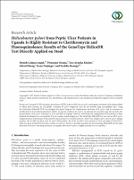Helicobacter pylori from Peptic Ulcer Patients in Uganda Is Highly Resistant to Clarithromycin and Fluoroquinolones: Results of the GenoType HelicoDR Test Directly Applied on Stool
Date
2017Author
Angol, Denish Calmax
Ocama, Ponsiano
Kirabo, Tess Ayazika
Okeng, Alfred
Najjingo, Irene
Bwanga, Freddie
Metadata
Show full item recordAbstract
Background. Around 70–90% of peptic ulcer disease (PUD) is due to Helicobacter pylori and requires treatment with antimicrobials
to which these bacteria are susceptible. Common H. pylori diagnostic tests do not provide drug susceptibility data. Using
the GenoType HelicoDR PCR test designed for gastric biopsies for simultaneous detection of H. pylori and its resistance to
clarithromycin (CLA)/fluoroquinolones (FLQ), we present evidence for stool as an optional test specimen and also provide data
on prevalence of H. pylori resistance to CLA and FLQ in Uganda. Methods. Stool from 142 symptomatic PUD patients at three
hospitals in Kampala was screened for H. pylori using a rapid antigen test.The GenoType HelicoDR test was run on all H. pylori
antigen positives to determine PCR positivity and resistance to CLA/FLQ. Results. Thirty-one samples (22%) were H. pylori antigen
positive, and 21 (68%) of these were H. pylori PCR positive. Six of the 21 (29%) were resistant to CLA and eight to FLQ (42%),
while two gave invalid FLQ resistance results. Conclusion. Stool is a possible specimen for the GenoType HelicoDR test for rapid
detection of H. pylori and drug resistance. In Uganda, Helicobacter pylori is highly resistant to CLA and FLQ.

